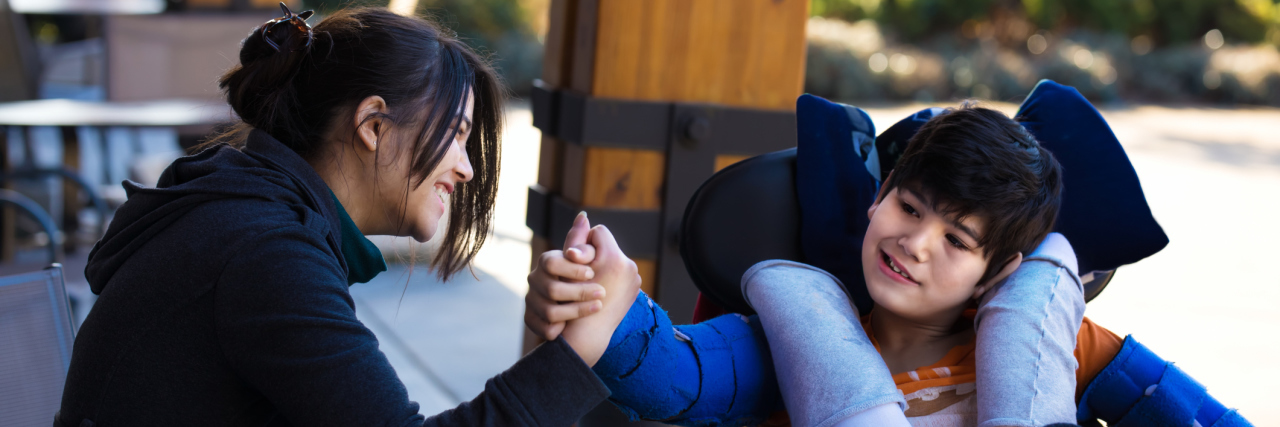Inclusion really can be simple. There are overwhelming amounts of research that prove inclusion works and is beneficial to all kids. Here are five ways for organizations to create inclusive programs and guarantee that all kids get to just be kids.
1. Market programs.
If you want parents to know you offer inclusive programs, you have to market it. Make sure your website and social media sites speak to inclusion and being open to people of all abilities. Parents who live in the disability world can help you with choosing the right words and phrases and help connect you to local disability organizations who can direct families to your programs. Inclusion has to become a part of your brand and how people talk about your company. It’s not enough to just be inclusive. You have to talk about it. You have to let people know about it. When community businesses and non-profits embrace diversity and talk about it openly, it spreads acceptance and encourages others to follow.
2. Foster relationships.
Many kids with disabilities have spent their whole lives segregated, either as a result of that or as a function of their disability, they may find it difficult to independently create natural social interactions. As the leader in your environment, others will look to you for clues on how to socialize and engage with peers, disabled or not. For helping a child with disabilities become acclimated, the goal is to foster relationships and then fade your support and presence. Talk openly about differences and emphasize similarities. Help introduce kids who you know have common interests and step back as they get to know each other. Kids don’t see things the way adults do. They are much more accepting. Just help them navigate situations that may be unfamiliar. Once you help break down the barriers, friendships may quickly be made.
3. Embrace trial and error.
This one is important. No one expects you to have all of the answers, to know all of the right tactics or to get everything right. Navigating life with a disability is a constant learning experience. Some days things work. Some days they don’t. Some days a kid struggles and others they breeze through. This is true for all kids. Don’t worry about not knowing exactly how to adapt a drill or an exercise. The child may adapt things on their own so you can follow their lead to develop skills from their adaptation. Ask parents. Just make an effort and try. Some things will fail and that’s OK. Others will be successful. It’s all part of life but realize that for many kids, failure is all that has ever been expected. They have been told what they can’t do or won’t do. When you invest in the success of a child like that, when you presume they are competent and capable and you help them see that in themselves, your world and theirs will be changed for the better.
4. Focus on strengths.
I highly recommend reading the book “Strengths Based Leadership” by Tom Rath and Barrie Conchie. The idea is to focus on areas of strength rather than emphasizing areas of weakness. Every child has strengths. Children with disabilities are constantly reminded of and spend time focusing on their weaknesses. Focusing on what a child does well and using that to drive their growth in programs is key to building confidence and creating a positive path for success. Always assume a child is capable, but don’t confuse capability with uniformity. One child’s success does not have to look exactly like another’s. Give the book a read and think about how you can apply strengths based principles in an inclusive environment. Zero in on what the child can do well and build skills from there. When you build from a place of strength rather than weakness, your whole mindset changes. Weaknesses still get attention but don’t become the primary focus of effort. You will play a critical role in developing a child into who they will become as an adult. Make it count.
5. Celebrate progress.
Life is about progress, not perfection. If growth and progress are happening, point it out. Celebrate it. If a child learns and follows a routine without protesting, recognize their effort. When a new skill is accomplished, talk about it. If social interactions are initiated or a fear is overcome, call attention to it. You most likely do that anyways. Just be sure to look at different ways a child with disabilities may be progressing. If testing or demonstrating a skill is required for moving to another level or section, consider how the path forward may look different for a child who has a disability. Schools mistakenly believed that in order for a child to be with everyone else, they had to accomplish what everyone else did. But that’s not what inclusion means. Inclusion is the ability to be with peers, having the same experiences and growing through life stages. Disability does not define potential. If a child is progressing in their own right, celebrate it and encourage them to keep going.
Inclusion shouldn’t be a fight, but it is. There is no qualifier to participate in life. There is no qualifier to be present in life. Yet many organizations use the presence of a disability to disqualify a child from participating. Organizations that are stuck on “can’t” instead of figuring out how. Move the world forward. Become inclusive.
”Everybody is a genius. But if you judge a fish by its ability to climb a tree, it will live its whole live believing that it is stupid.” —
Albert Einstein
A version of this story originally appeared on White Hawk Advocacy.
Getty image by jarenwicklund

